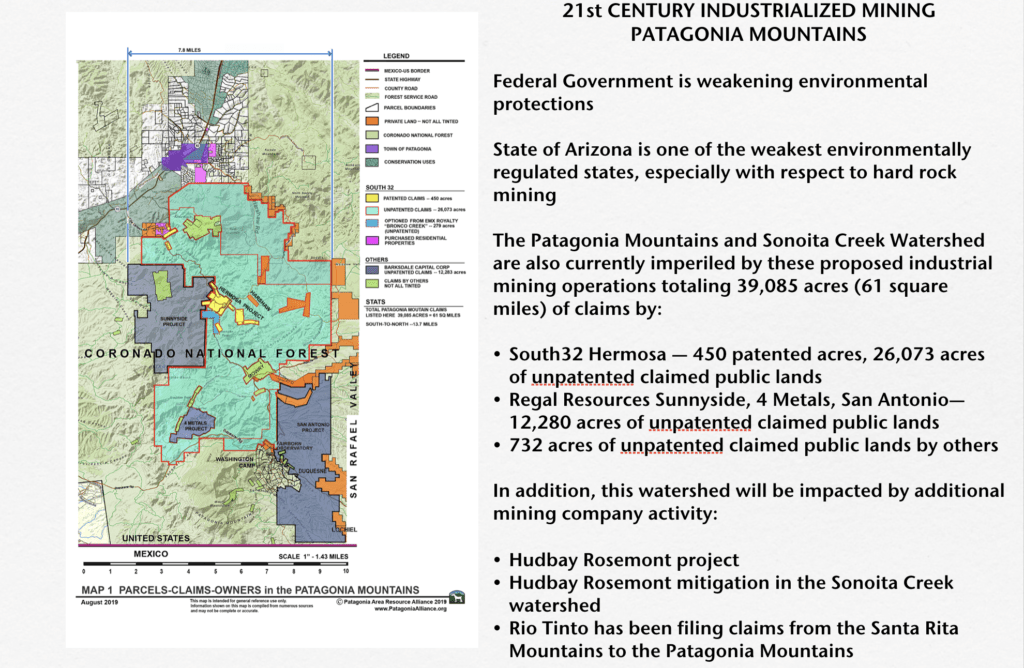
21st Century Industrialized Mining Threats in the Patagonia Mountains




National Environmental Policy Act (NEPA): The Scoping Process
NEPA was signed into law on January 1, 1970 by President Richard Nixon as the result of massive citizen advocacy for environmental protections. WE THE PEOPLE have the right and the responsibility to protect the ecosystem that supports all life forms. NEPA defines a scoping process to submit comments to public agencies when projects are proposed on public lands.
This comment process is about the Sunnyside project in the Patagonia Mountains. The Sunnyside project is approximately 5,000 acres of unpatented claims on Forest Service public lands. The project owners and the Forest Service representatives have worked together to create a Plan of Operations to drill 30 exploratory holes on a 24/7 schedule over a seven year period and the Forest Service proposes to proceed with an Environmental Assessment (EA). Now the Public has 45 days to comment (deadline is October 21) on why an Environmental Impact Assessment (EIS) should be required.
An EA is a concise review document taking into account the purpose and need of the proposal, any alternatives, and a brief review of the impacted environment. An EA will either result in a Finding of No Significant Impact (FONSI) or if significant environmental impacts appear likely, an EIS.
An EIS is a much more comprehensive document which requires everything an EA would require while also requiring a much more comprehensive discussion of the reasonable alternatives and a “hard look” at the cumulative impacts of the proposal along with all existing and reasonably foreseeable future development within the project area.
The use of an EA rather than an EIS means that an agency is not required to assess the cumulative impacts of the proposal along with all other existing and reasonably foreseeable future development nearby.
Cumulative impacts clearly exist in the Patagonia Mountains due to multiple proposed mining projects and, therefore, this reason alone should require an EIS.
Scoping Comments in General:
Comments are due by October 21, 2019 and can be submitted by mail or online and should reference “Sunnyside Exploration Drilling Project.”
If submitted online:
https://cara.ecosystem-management.org/Public/Commentinput?Project=55719
If submitted by mail:
Sierra Vista Ranger District
c/o Rick Goshen
4070 S Avenida Saracino
Hereford, AZ. 85615
Comments must pertain to the current Plan of Operations for exploratory drilling not the potential mine. Be positive when possible in your discussion and forthright with your concerns. You don’t have to do the analysis for the agency, you only need to identify the issues and potential impacts that must be analyzed. Personal: begin by saying something about yourself and why this issue is important to you. Then add the issues that are important to you. Here are comment topics and suggested statements:
Suggested Scoping Comments Smorgasbord (pick & choose BUT please everyone at a minimum ask for an EIS as stated in the first comment below):
1. Cumulative impacts clearly exist in the Patagonia Mountains due to multiple proposed mining projects and, therefore, this reason alone should require an EIS. The cumulative impacts include, but are not limited to:
Abandoned leaking mines
Other Mining Company Activity
Cattle Grazing
Border Patrol
Recreation Activity
2. Wildlife
The proposed project will take place in a Mexican Spotted Owl Protected Activity Center. Cause-effect relationship: the proposed drilling operation will dramatically and irretrievably disturb the owls.
There are many Federally threatened and endangered species in the Patagonia Mountains. Cause-effect relationship: the proposed drilling operation will dramatically and irretrievably disturb all species.
The Patagonia Mountains are a significant corridor for wildlife movement and one of the few remaining long range corridors. There is “no action alternative” to disrupting this corridor.
3. Water Quality and Water Quantity: There is “no action alternative” to protecting our water quality and quantity.
This Plan of Operations proposes to truck in water from other “confirmed” sources. All those “confirmed” sources are upstream or downstream of this project. All watersheds are connected.
A comprehensive study should be conducted of the entire groundwater system throughout Santa Cruz County because there is significant science on changing water conditions due to ongoing drought with all science indicating worsening conditions for the foreseeable future.
This project will occur in a Forest Service designated Municipal Watershed (Town of Patagonia).
4. Air Quality: There are federal agencies reporting that the air quality in the Patagonia area has been declining. This must be reversed. All mining activities (exploratory or otherwise) will have a negative impact on air quality. There is “no action alternative” to protecting the vital air that we breathe into our bodies.
5. Soils: This area is increasing its local food production. Mining activities will expose toxic materials that are likely to leach into the soils of outlying areas through air and water migration.
6. Cultural Resources: The Patagonia Mountains are known to have been inhabited for more than 10,000 years. All efforts must be made to identify and protect these cultural resources.
7. Dark Skies: Everyone who visits this area comments on the beauty of the dark skies. What impact will 24/7 operations have upon this recreational activity?
8. Road Disturbance: This level of road disturbance in an area with multiple endangered species and designated protected areas is unacceptable.